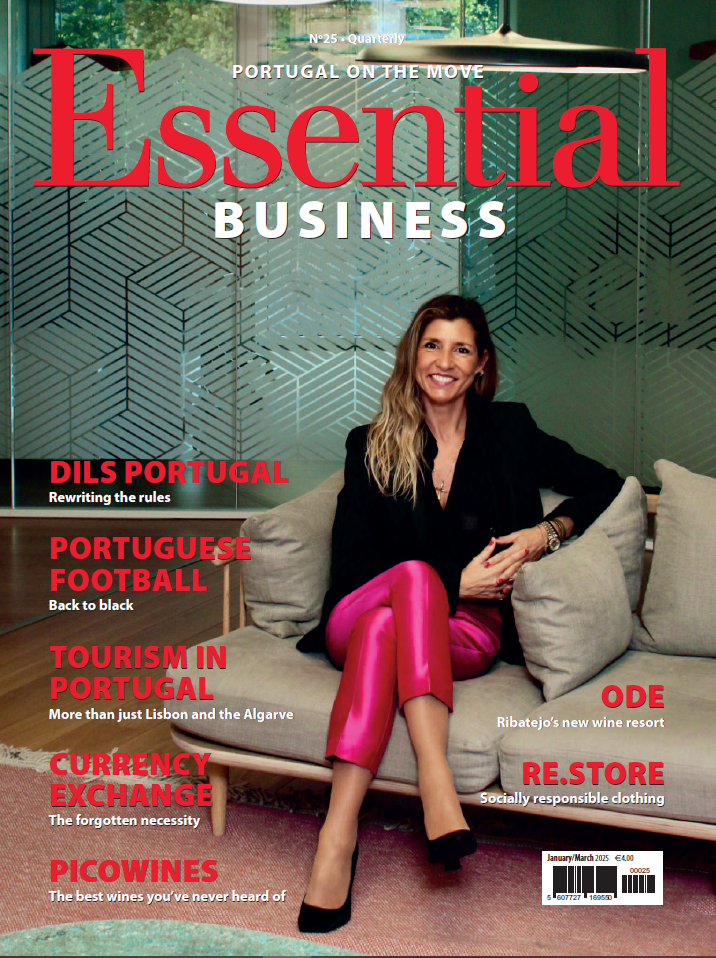Lisbon Art and Antiquities Fair reveals lost and long-hidden royal treasures
A long-lost portrait of King João V, watercolors by a French duchess, and an intimate painting of a Portuguese queen by her son were some of the treasures to be found at Lisbon’s most popular antiques fair this week.
Text & Photo: Chris Graeme
The Lisbon Art & Antiquities Fair (LAAF) returned to Lisbon at the Cordoaria Nacional between May 9 and 17 in the city’s Belém district, bringing together art galleries, antique shops, objets de virtue, interior designs, contemporary furnishings, religious art and rare central asian carpets to name but a few of the collectables in the stalls that occupied 1,30m2 of space either side of an extended corridor running the length of the former naval rope-making factory that today is an events and exhibition centre.
The President of the Republic, Marcelo Rebelo de Sousa, was due to arrive shortly after 5pm on the Friday to mark the opening of the event, but was detained because of the simultaneous announcement that the new Pope Robert Prevost (Leo XIV) had been elected in Rome.
The event was packed with art dealers, collectors and the simply curious who mingled across the space with the usual splattering of Portuguese television presenters and figures from the pages of the country’s society magazines.
The annual event, now in its 22nd edition, is organised by the Portuguese Association of Antique Dealers (APA – Associação Portuguesa dos Antiquários), and this year’s special guest was the Portuguese landscape painter Pedro Calapez with four works of art featured from his Lameiros series in which the painter in a sensorial and poetic manner captured the different seasons in the Northeast Trás-os-Montes region of Portugal.
A packed programme
The programme of events included the launch of the book ‘Notebooks from my Life – Number 16’ by internationally renowned Portuguese artists Joana Vasconcelos and Lucia Bertazzo and a lecture on ‘Chinese Art – From the South Seas of China to the Imperial Court (1580-1900)’ from Professor Luís Urbano Afonso and Hugo Miguel Crespo.
There was also a lecture on Portuguese Azulejo blue tiles ‘Azulejo: A Heritage with a Future’ with Professor Rosário Salema de Carvalho, Director of the National Museum of Azulejos (Museu Nacional do Azulejo), and a book launch for ‘Primavera 2025’ (Spring 2025) organised by Susana Jacobetty.
Some 15,000 visitors are expected to visit the event’s 35 national and international exhibitor stalls and attend the various talks, launches and presentations.
The Vice-President of the APA, Francisco Pereira Coutinho, said that more visitors were expected this year, particularly more foreigners. “Not just overseas residents here in Lisbon but also tourists”.
“Popularity for antique pieces depends on the branch of collectables concerned and how popular they are since these tend to follow trends. Furniture, for example is less popular right now and more difficult to sell, but overall the market is very buoyant with contemporary art doing well, so it depends on the segment”, he explained.
Essential Business spoke to some of the exhibitors about the pieces on display at this popular annal event.
Charming miniature portraits of royalty
Philippe Mendes, who is a Portuguese Paris-based art dealer (Galeria Mendes) and is currently preparing to open his first gallery in Lisbon’s Lapa district by the end of the year, concentrates on Italian, French, Spanish and Portuguese painting from the 16th-19th centuries. However, sometimes he dips his toes into contemporary art too.
Philippe shows me three ensembles of art that are among his favourites: A small collection of four drawings by Domingos António de Sequeira (1768-1837) who was a famous Portuguese painter at the Royal Court of King John IV of Portugal, all from different periods in the artist’s career in Portugal, although he spent the last years of his life in Rome working on devotional pieces.
Interestingly enough, in 2016, Lisbon’s Museum of Old Art (Museu de Arte Antiga) launched a crowdfunding campaign to buy the artist’s painting ‘The Adoration of the Magi’ for €600,000 and succeeded.
Philippe tells me that interest in Portuguese painting has been on the rise over the past 10 years, but thinks more of an effort needs to be made by the large international galleries to acquire more Portuguese painting which is often either not known or overlooked internationally.
He also shows me four watercolors of riparian views of the River Tagus by artist Princess Françoise d’Orléans, Duchess of Chartres, a Portuguese-French 19th century artist whose work has been offered at auction multiple times, with prices making from US$843 to US$1,088. Philippe says that these, however, are “exceptional, unparalleled and never before seen works”.
Other marvellous works on display included works by Portuguese King Dom Carlos (who was an avid, prolific and rather good artist) which have just been bought by Portuguese museums the names of which he was not at liberty to reveal. The pieces all came from outside of Portugal – Germany, Italy and France.
One of the charming paintings is of his mother Dona Maria Pia painted on a tambourine drum standing at a window at her chalet in Estoril which the king touchingly offered to her at a ball in 1903 at the Fortress of Cascais.
Another is a miniature of Portuguese Queen Dona Maria II by Scottish painter William Charles Ross (1794-1860) who the artist painted in or around 1852. Tragically, this was one of the last paintings executed of the queen for she was dead within a year from a postpartum infection.
The pièce de résistance, however, is an original model of the monument to Portuguese Queen Dona Maria I commissioned from sculptor João José de Aguiar in 1794 in Rome, which today stands at the entrance of the Baroque National Palace of Queluz near Lisbon.
Lovely scenes of XVIII life
A stand of interest was D’Orey Azulejos & Antiguidades from Manuel d’Orey Capucho who specialises in Portuguese traditional tiles from the XVIth century and the blue and white Azulejo tiled panels from the XVII and XVIII centuries and blue and green tiles for Moorish-influenced geometric motifs.
“It’s very rare to have tiles depicting figures before the XVIIIth century when the blue and white tiles took off and there was a boom with large, artisan-made blue-and-white figurative scenes made up of tiles designed by academically-trained Portuguese artists whose work became the dominant fashion, superseding the former taste for repeated patterns and abstract decoration,” he explains.
Manuel shares that he has been in the antiques trade since he retired in 2008. “I was a collector and now it’s a family business with my nephews working with me,” he says, adding that he likes to “buy and reconstruct them” as he shows me rebuilt panels from lost tiles dating from the XVIIIth century reconstructed by an artist. “It’s very popular right now”.
Manuel tells me that there is a lot of interest from foreigners, particularly Americans and Brazilians, but others too who buy these antique Azulejos to decorate their homes in Portugal. The gallery also exports overseas but has to ask permission from the appropriate authorities for very fine pieces.
But he also loves stonework and shows me figures from the 17th and 18th centuries: a statue of Saint Anthony and some gargoyles from the 15th century.
He says that the reason why there is so much devotional and religious art such as saints and statues and figures of Our Lady on the market in Portugal was because in the 19th century many religious institutions such as monasteries and convents closed and the contents sold. He particularly likes the naive and fantastic quality of some of these.
Rare and exotic carpets from Central Asia and the Far East
Next stop on my tour of the Lisbon arts and antiques fair was Tricana Gallery which sells antique and contemporary rare restored carpets from Turkey, the Middle East and Central Asia and the Far East.
Oriental carpet expert and dealer Celal Ozturk, who came to Portugal from Turkey in 1990, shows me a delicate and exquisite Venetian carpet dating from the XVIII made in China and others in pure silk from Turkey. Some of these carpets have a quality of 1 million knots per square metre.
“Such top quality carpets take at least a year if not 18 months to be made by the hand of just one artisan. Others can take three people up to three years to make,” he explains showing me an hand-made Persian pure silk carpet.
He tells me that Tricana, based in Rua São Bento 28, in Lisbon, was founded in Coimbra by Joaquim Baeta in 1944 who began a long family tradition of rugs and carpets that exists to this day. Today, it has shops all over Portugal in Lisbon, Porto, Cascais and Almancil, and overseas contacts in Istanbul and Anatolia in Turkey.
“Each carpet is a work of art to be passed down and enjoyed from generation to generation like as family heirloom” he says, unfurling several carpets as deftly as a seller in an Istanbul bazaar, before proudly showing some very special carpets that are between 100 and 200 years old from Anatolia, the Caucasus region and Kazakhstan.
Primarily made in villages, rather than in cities, these carpets are made from materials particular to individual tribal provinces while the rugs of the Caucasus region normally display bold geometric designs in primary colors with different styles from Daghestan, Verne, Shirvan, Ganja, Kazakh, Karabagh, and Quba.
But Tricana also has an atelier in Portugal where they mend, restore and sell Portuguese carpets such as Arraiolos and Beiriz and also have a washing service where their carpet experts offer exactly the same service and method of cleaning done in Turkey.
A lost painting of a king rediscovered
José Sanina who started his eponymous antiques business in 2001 in Lisbon on Rua São Bento says of the market in Portugal that many years ago many US and French dealers bought pieces from Portugal. The Chinese market was buoyant some years ago and before that the Brazilian.
“Things changed more recently because we have French, US, German and English buyers in Portugal who relocated here, bought houses and started picking up pieces to furnish them”, José said. “As for the Brazilians, it’s a market that has fallen substantially. I’ve done fairs in Brazil and there’s not so much interest for Portuguese objets d’art”.
His stall at LAAF reflected his very eclectic taste with devotional art, porcelain, silverware and paintings. “I choose only very fine, high-quality pieces and am eclectic because I love a lot of things”.
However, the star of the representative selection of artworks at this stall was undoubtedly an outstanding portrait of Portuguese King João V by Italian painter Domenico Duprá. (Turin 1689-1770).
The painter was invited to be the official court artist in 1719, a position he held until 1730 when he left Portugal for Italy.
As “King João V was probably the most important king we had in Portugal and this painting had been lost for 31 years, the State wanted to acquire it, but unfortunately I’ve already sold it to a collector.” (In fact he had just sold it over the phone 10 minutes before I interviewed him at LAAF for an undisclosed sum!)
Another impressive piece is a gold leaf decorated baroque oratory that had come from an “important mansion in the north of Portugal’s Douro region” made in the beginning of the XVIIth century.
So, at LAAF some of the pieces this year certainly were of royal origin and all had interesting stories behind them to tell. The experience was a bit like being on the UK’s Antiques Roadshow chatting to the experts. But don’t expect a Bargain Hunt. Most things here will set you back an arm and a leg. It’s certainly a fair only for well-heeled collectors and celebrities who like to dress to impress!
Image: José Sanina in front of a beautiful 18th century oratory from a house in the Douro region of Portugal










